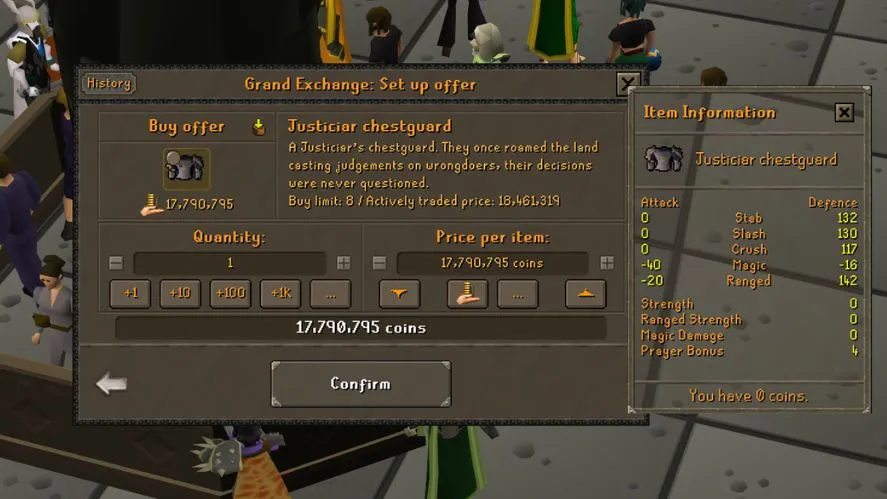Your cart is empty
Best Rune Armor in OSRS Ultimate Guide for Free-to-Play and Members

Old School RuneScape (OSRS) offers a vast world of combat, quests, and gear, with rune armor standing out as a cornerstone for many players. Whether you’re a free-to-play (F2P) warrior or a member chasing rare variants, rune armor provides excellent defense and iconic style. This guide dives into the best rune armor sets, their stats, uses, and how to get them, helping you optimize your gameplay in 2025.
Rune armor is a staple in OSRS, especially for F2P players, due to its balance of affordability and high defensive stats. Requiring level 40 Defence (and Dragon Slayer I for the platebody), it’s the best non-degradable armor in F2P worlds. For members, unique variants add flair and minor boosts, making rune armor versatile for PvP, PvE, and skilling. Its teal (or cyan, depending on the source) hue is instantly recognizable, symbolizing a milestone for many players.
Key Benefits of Rune Armor
- High Defense Stats: Offers excellent protection against melee and ranged attacks.
- Accessibility: Affordable for most players, with a full set costing around 130,000 coins.
- Versatility: Suitable for slayer tasks, training, and low-to-mid-tier bossing.
- Iconic Look: A classic design that screams OSRS nostalgia.
Best Rune Armor Sets for Free-to-Play Players
For F2P players, rune armor is the pinnacle of non-degradable gear. Below are the top pieces and setups to prioritize.
Rune Platebody
The rune platebody is the heart of any F2P melee setup, requiring completion of the Dragon Slayer I quest. It boasts +82 stab, +80 slash, and +72 crush defense, making it ideal for tanking melee-heavy foes like hill giants or lesser demons.
Rune Full Helm
With +30 stab, +32 slash, and +27 crush defense, the rune full helm is a must-have. It’s lightweight and pairs well with any melee build, offering solid protection without breaking the bank.
Rune Platelegs vs. Plateskirt
Both rune platelegs and plateskirt provide identical stats (+51 stab, +49 slash, +47 crush defense), so the choice comes down to aesthetics or cost. Platelegs are slightly more popular, but plateskirts can be cheaper at times, hovering around 37,000 coins.
Rune Kiteshield
The rune kiteshield offers +44 stab, +48 slash, and +46 crush defense, with a minor -3 ranged attack penalty. It’s a staple for F2P warriors facing high-damage melee opponents.
Optimal F2P Rune Armor Setup
For F2P, the best setup is:
- Rune Platebody
- Rune Full Helm
- Rune Platelegs or Plateskirt
- Rune Kiteshield
- Amulet of Strength (for budget damage boosts)
This combo maximizes defense while keeping costs low, perfect for training at places like the Stronghold of Security or PvP in the Wilderness.
Rune God Armor for Members
Members can access rune god armor, which adds a +1 prayer bonus per piece and unique aesthetics tied to gods like Saradomin, Zamorak, Guthix, Armadyl, Bandos, and Zaros. Obtained via hard Treasure Trails, these sets are functionally identical to standard rune armor in defense but shine in specific scenarios.
Why Choose God Armor?
The +1 prayer bonus per piece (up to +4 for a full set) extends prayer duration, which is handy for slayer tasks or God Wars Dungeon (GWD) runs. Wearing a god’s armor in GWD makes their followers non-aggressive, saving you from constant combat.
Best God Armor Variants
| God Armor | Color | Best Use | Approx. Cost (2025) |
|---|---|---|---|
| Saradomin | White | GWD (Saradomin boss), prayer-heavy tasks | ~500k–1M |
| Zamorak | Red | GWD (Zamorak boss), PvP aesthetics | ~600k–1.2M |
| Guthix | Green | GWD (Guthix followers), budget option | ~400k–800k |
| Armadyl | Silver | GWD (Armadyl boss), rare collectible | ~1M–2M |
| Bandos | Brown | GWD (Bandos boss), tanking | ~800k–1.5M |
| Zaros (Ancient) | Purple | GWD (Zaros followers), rarest variant | ~1.5M–3M |
Note: Prices fluctuate based on Grand Exchange trends, so check regularly.
Saradomin Rune Armor
With its white trim and + star symbol, Saradomin rune armor is a favorite for GWD runs against Commander Zilyana. The prayer bonus helps sustain Protect from Melee, making it a top pick for prolonged fights.
Zaros (Ancient) Rune Armor
The rarest god armor, Zaros variant sports purple trim and is highly sought after for its prestige. It’s ideal for collectors or players tackling Nex, where Zaros alignment prevents aggression from her minions.
Ornamental Rune Armor Variants
Beyond god armor, ornamental variants like trimmed, gold-trimmed, gilded, and heraldic rune armor offer cosmetic flair. Obtained from clue scrolls, these are mostly for flexing, though god-trimmed kiteshields have a slightly worse -2 ranged attack penalty versus -3 for standard.
Gilded Rune Armor
Gilded armor, with its gold accents, is a status symbol. A full set can cost 2–5M coins, but it’s purely cosmetic, offering no stat advantage over standard rune. It’s perfect for players wanting to stand out in Varrock Square.
Trimmed and Gold-Trimmed Armor
Trimmed (black trim) and gold-trimmed (gold trim) armor are also clue scroll rewards. They’re cheaper than gilded (500k–1M) but equally cosmetic, ideal for budget-conscious fashion enthusiasts.
Heraldic Rune Armor
Heraldic armor comes in five patterns, each tied to a clue scroll tier. Stats match standard rune, but their unique designs make them collectibles for castle decorators or clan events.
How to Get Rune Armor in OSRS
Acquiring rune armor is straightforward, but methods vary by playstyle and membership status.
Buying from the Grand Exchange
The easiest way is purchasing from the Grand Exchange. A full standard rune set (platebody, platelegs, full helm, kiteshield) costs ~130,000 coins, while god or ornamental sets range from 400k to 5M.
Smithing Rune Armor
With 85+ Smithing, you can craft rune armor from runite bars. For example, a rune platebody requires 5 bars and level 99 Smithing, yielding profit if sold (plateskirts are currently most valuable at ~37,000 coins post-tax). Use Varrock west bank (F2P) or Prifddinas (P2P) for efficient smithing.
Treasure Trails for Ornamental Variants
God, trimmed, gilded, and heraldic armor drop from hard clue scrolls (or higher for some). Completing clue scrolls is RNG-heavy but rewarding, especially for Zaros or gilded pieces.
Monster Drops
Some rune pieces (e.g., platelegs, full helm) drop from monsters like obor, bryophyta, or greater demons. This is a slow method but viable for Ironmen.
Tips for Using Rune Armor Effectively
To maximize rune armor’s potential, consider these strategies:
- PvP in F2P: Pair rune armor with a rune 2h sword or scimitar for budget-friendly Wilderness fights. It’s cheap to replace if lost.
- Slayer Tasks: Use god armor for prayer-heavy tasks like dust devils to extend Protect prayers.
- GWD Prep: Match your god armor to your boss (e.g., Bandos for General Graardor) to avoid follower attacks.
- Combine with Offense: Equip a dragon defender (members) or amulet of strength to balance defense with damage output.
- Bank Ornamentals: Gilded and trimmed sets are cosmetic, so store them to avoid risking millions in PvP deaths.
Rune armor remains a timeless choice in OSRS, blending practicality with prestige. Whether you’re rocking a standard set in Lumbridge or flexing gilded armor in the Duel Arena, it’s a gear tier that defines the game’s essence. For F2P players, it’s the ultimate goal; for members, it’s a stepping stone with collectible flair. Grab your set, complete Dragon Slayer I, and dominate Gielinor in style!
